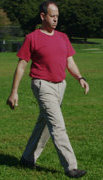 When I speak about the core I am referring to three main muscle groups: The inner thighs, the pelvic floor and the abdominals. The psoas (my favorite muscle) is the main engine of walking, standing and trauma and when it is properly toned and aligned it allows the body to move with the most efficiency and ease. Without balance and tone in our core the psoas won’t be free to function at its best.
When I speak about the core I am referring to three main muscle groups: The inner thighs, the pelvic floor and the abdominals. The psoas (my favorite muscle) is the main engine of walking, standing and trauma and when it is properly toned and aligned it allows the body to move with the most efficiency and ease. Without balance and tone in our core the psoas won’t be free to function at its best.
- The inner thighs, known as the adductors (there are five of them), tend to be weaker than the outer thighs and in almost all cases need to be awakened to their proper role in walking.
- The pelvic floor, muscularly known as the levator ani (three muscles), is called upon to serve a different role in modern man than in our predecessors. Our shift from quadruped to biped has not been an easy one. If you think about four-legged animals, the pelvis is the back wall of the body so the abdominal wall supports the internal organs. As a result of standing upright, our pelvic floor has become responsible for holding up our organs. This shift in responsibility is well deserved of our attention.
- The belly is made up of four abdominal muscles all of which need balanced tone to function properly as they are essentially connected through assorted structures of the inner body. The average person will have much more tone in one or another of these muscles for different reasons. Classically we are way too developed in the most surface of these muscles, the rectus abdominus – otherwise known as the six-pack.
Proper tone and balanced function in these groups allows for the correct alignment of the legs, pelvis and lumbar spine, which creates the best environment for housing the internal organs and this frees the psoas to work at its best.
Learning to develop these muscle correctly when exercising, and then using them successfully when walking and standing builds an enduring strength to carry us through life. This helps us from chronic pain and injury as well as setting us up for the ever elusive goal of aging gracefully.
